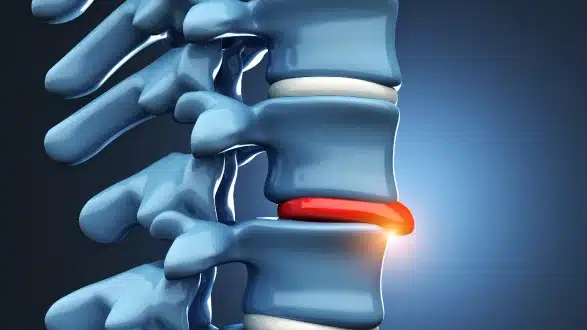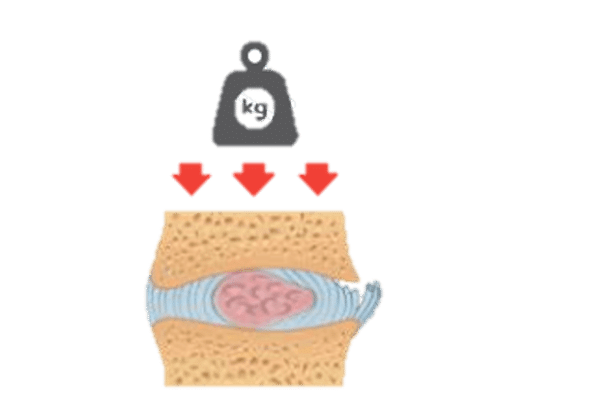Request Appointment
Enter your details and we will be in touch with you shortly;
Or call
8655885566
between 8 am and 8 pm.

A condition in which the intervertebral disc rutures and moves out of its alignment

The wear and tear in the spine can cause damage in soft muscle tissue, which can lead to excess pressure on bones and discs. This causes the disc to move from its alignment and causes disc herniation, usually referred to as a slipped disc. Slipped disc treatment focuses on alleviating pain, restoring movement, and preventing long-term complications. It is therefore evident that timely intervention is crucial in the recovery process of any crisis. To get the right treatment promptly, these are the symptoms to watch out for:
It results to a sharp pain in the upper back which may spread along the arms, or one in the lower back that may extend down to pelvic and thighs. This radiating pain is often managed through slipped disc therapy, which targets the source of nerve compression.
The durations of the pain may range from just a few hours to several weeks. If the discomfort continues or worsens, a structured herniated disc treatment plan may be necessary to relieve pressure on the nerves and support healing.
Sitting or standing for an extended period can even make the pain worse. Just as in the case of shifting our position while sitting, shifting positions might provide momentary comfort. Patients often benefit from slipped disc relief therapy, which combines movement modification and spinal support techniques.
Sustained and severe muscle contraction in the back can be very discomforting and become a hindrance in the activities we perform in our day-to-day lives. To manage this, a comprehensive slipped disc relief treatment approach may be recommended, which includes medication, physical therapy, and strengthening exercises.
 Professional diagnosis required
Professional diagnosis required Chronic, can last for years
Chronic, can last for years Treatable with 8 weeks of QI Spine Therapy
Treatable with 8 weeks of QI Spine TherapyThe most common cause of a slipped disc is aging. Over time, the hard encasement of the vertebrae becomes brittle, and the gel inside slips through the cracks. However, there are other lifestyle-related causes like:
Most slipped-disc cases can be treated non-surgically, with the aid of physiotherapy. But, Different lifestyle risks present during each stage of life can be prevented when identified early to delay or prevent disc damage. However, if symptoms do arise, a guided recovery plan that includes slipped disc treatment and preventive care is the best way to restore comfort and mobility.
 Professional diagnosis required
Professional diagnosis required Chronic, can last for years
Chronic, can last for years Treatable with 4 weeks of QI Spine Therapy
Treatable with 4 weeks of QI Spine TherapyDepending on the severity of the case, a slipped disc can be treated in the following ways:
Even in the case of surgery, follow-up rehabilitation helps sustain and improve the results.
 Professional diagnosis required
Professional diagnosis required Chronic, can last for years
Chronic, can last for years Treatable with 4 weeks of QI Spine Therapy
Treatable with 4 weeks of QI Spine TherapyDepending on the severity of the case, a slipped disc can be treated in the following ways:
Even in case of surgery, follow-up rehabilitation helps sustain and improve the results.
 Professional diagnosis required
Professional diagnosis required Chronic, can last for years
Chronic, can last for years Treatable with 4 weeks of QI Spine Therapy
Treatable with 4 weeks of QI Spine TherapyDiagnosis of a slipped disc is the first step when the symptoms mentioned are observed during the clinical examination. The first thing a spine specialist will do to diagnose the problem is to establish the area, intensity, and characteristics of the pain, any muscle weakness or numbness, and your mobility. According to the diagnosis and the patient’s past pain history doctor designs a personalized slipped disc pain relief treatment. Including slipped disc pain relief therapy. The therapy is based on exercises, yoga, medication, and even massage therapies.
Another common approach may be suggested by the doctors to confirm the diagnosis and to see how far the disc herniation has progressed:
There are two tests, Electromyography (EMG) and nerve conduction studies that may be done if the nerves are believed to be affected. These tests indicate the ability of electrical impulses to flow in nerves and muscles.
QI Spine diagnoses the pain with advanced spine analysis tests with the help of DSA. DSA (Digital Spine Analysis test) helps in analyzing the root cause of the problem. It is a non-invasive functional test that helps in measuring spine function. Its controlled and guided movements help in determining the mobility of the spine, strength, and imbalances of muscles around the spine.
Where CT Scan, MRI & X-Rays are performed to find the cause of the pain, these methods mostly fail to state the exact cause, but DSA analyzes the muscles directly and finds out the root cause.
Early and accurate diagnosis is essential to begin the right slipped disc treatment, whether it's through physical therapy, medications, or non-surgical methods. In any case, it is always important to seek the opinion of a specialist in spinal disorders if any of these symptoms persist or worsen.
 Professional diagnosis required
Professional diagnosis required Chronic, can last for years
Chronic, can last for years Treatable with 4 weeks of QI Spine Therapy
Treatable with 4 weeks of QI Spine Therapy






Have a question?
Ask our spine specialists
Who is a QI Spine Specialist?
A QI Spine Specialist is a medical expert with

Dr. Nidhi Sanghvi Shah

Dr. Shital Gaikwad

Dr. Richa Bhatia
9000 hours
of specialisation in treating back and neck conditions
32 hours
of spine physiotherapy specialisation methods in McKenzie concepts, Kinetic control, Neurodynamic solutions, Mulligan’s concepts
500 hours
and 6 months of QI Spine specialisation courses
Yes, walking helps improve circulation and reduces stiffness, making it an important component of a comprehensive slipped disc treatment plan.
Stretches to avoid scar tissue formation are the pelvic tilt, knee-chest exercises and basic movements targeting the core muscles. These exercises are integral to a structured slipped disc therapy program aimed at reducing pain and improving spinal mobility.
Recovery times vary, but many patients see significant improvement within 6-8 weeks with proper adherence to a personalized plan, such as herniated disc treatment protocols that may include physical therapy for slipped disc and non-surgical disc treatment strategies.
Poses such as Child’s Pose and Cat-Cow and Sphinx pose are effective exercises that are useful in stretching the back as well as the abdominal muscles thus relieving the pressure on the spinal nerves.